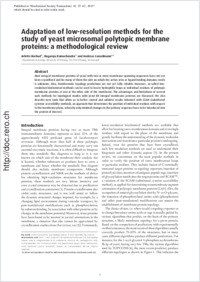Adaptation of low-resolution methods for the study of yeast microsomal polytopic membrane proteins: a methodological review
- Bochud, Arlette Department of Biology, University of Fribourg, Switzerland
- Ramachandra, Nagaraju Department of Biology, University of Fribourg, Switzerland
- Conzelmann, Andreas Department of Biology, University of Fribourg, Switzerland
-
2012
Published in:
- Biochemical Society Transactions. - 2013, vol. 41, p. 35–42
English
Most integral membrane proteins of yeast with two or more membrane-spanning sequences have not yet been crystallized and for many of them the side on which the active sites or ligand-binding domains reside is unknown. Also, bioinformatic topology predictions are not yet fully reliable. However, so-called low-resolution biochemical methods can be used to locate hydrophilic loops or individual residues of polytopic membrane proteins at one or the other side of the membrane. The advantages and limitations of several such methods for topological studies with yeast ER integral membrane proteins are discussed. We also describe new tools that allow us to better control and validate results obtained with SCAM (substituted cysteine accessibility method), an approach that determines the position of individual residues with respect to the membrane plane, whereby only minimal changes in the primary sequence have to be introduced into the protein of interest.
- Faculty
- Faculté des sciences et de médecine
- Department
- Département de Biologie
- Language
-
- English
- Classification
- Biological sciences
- License
- License undefined
- Identifiers
-
- RERO DOC 31823
- DOI 10.1042/BST20120212
- Persistent URL
- https://folia.unifr.ch/unifr/documents/302806
Statistics
Document views: 80
File downloads:
- con_alr.pdf: 190
